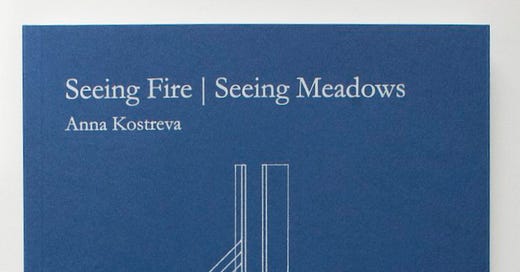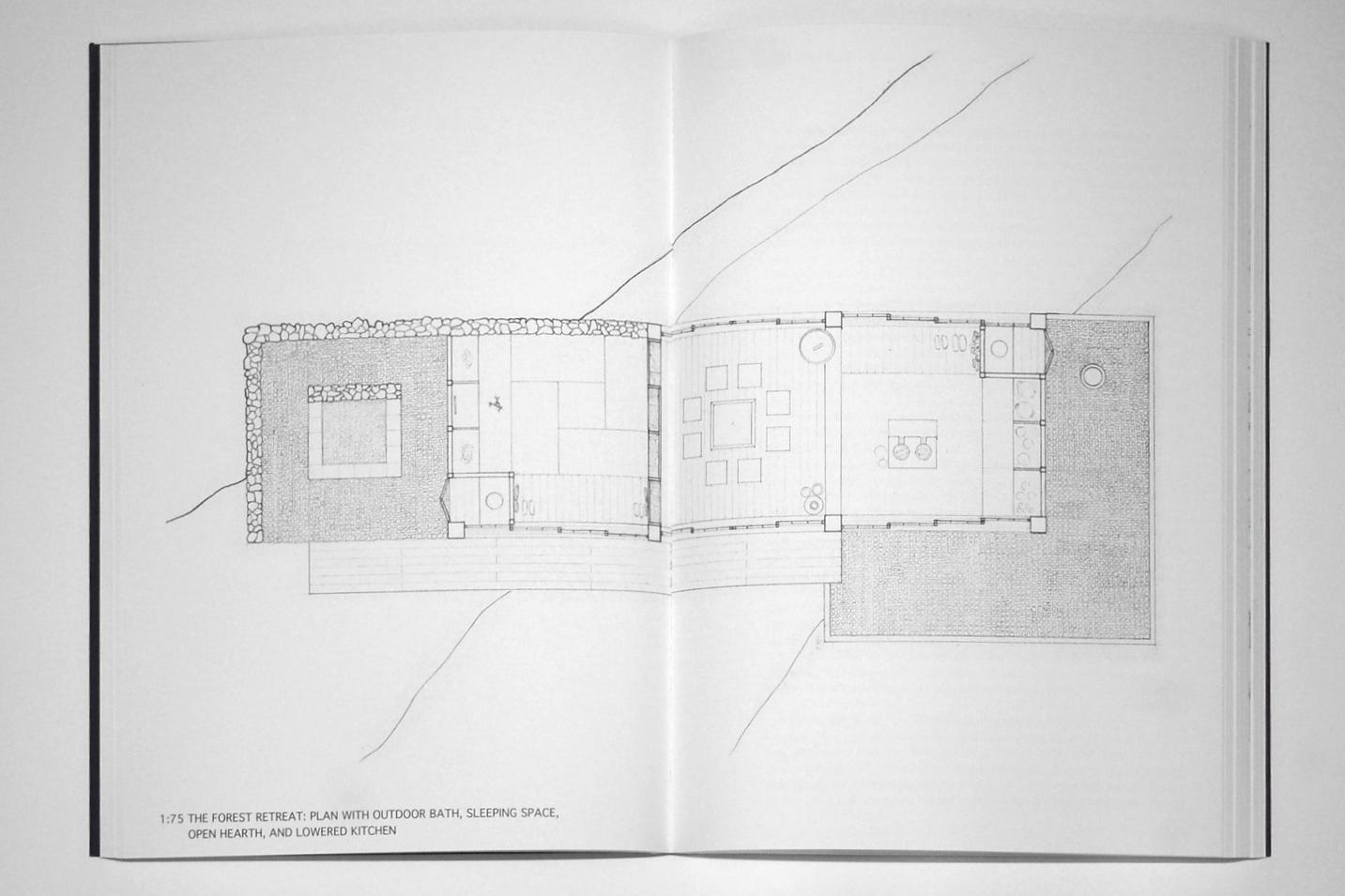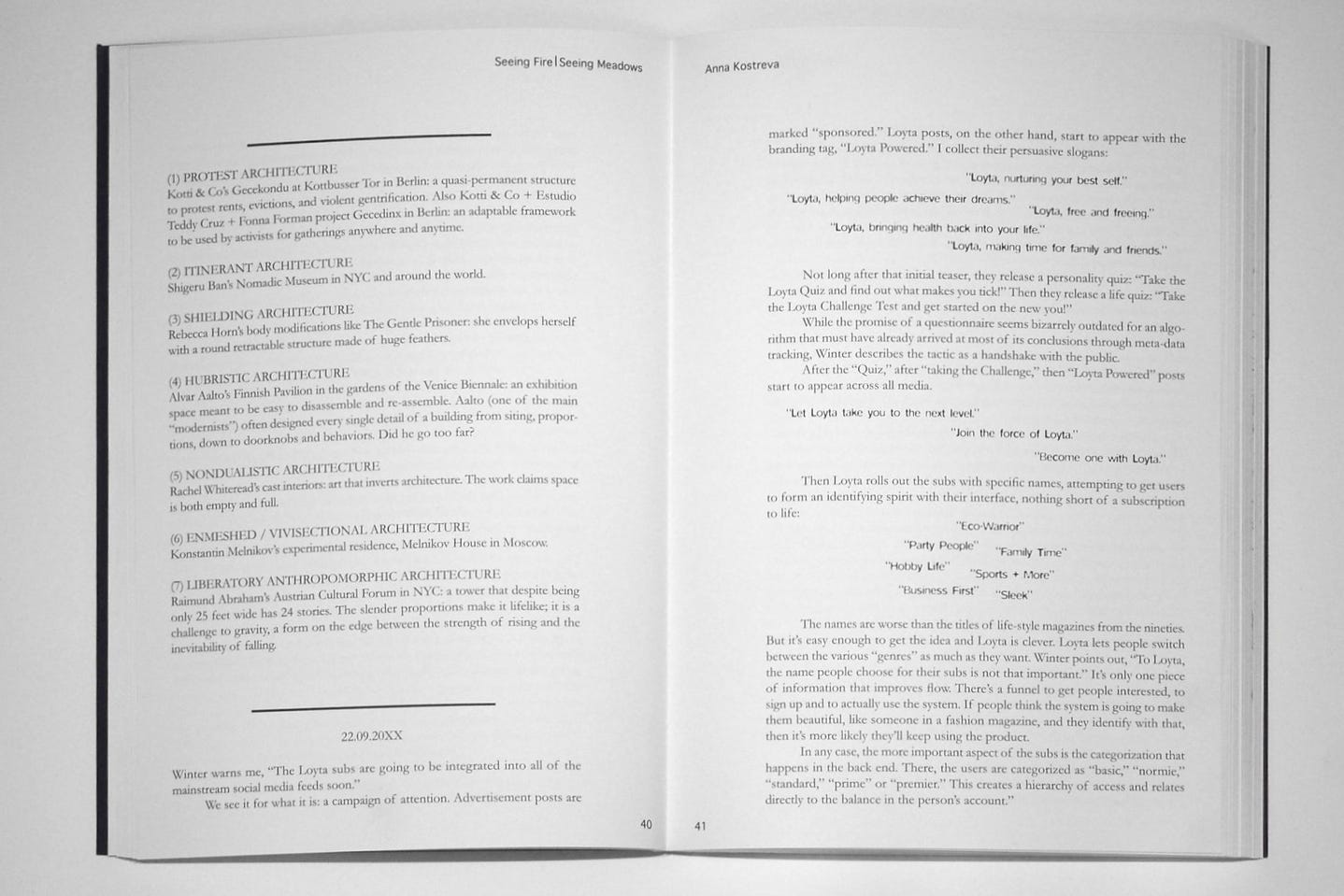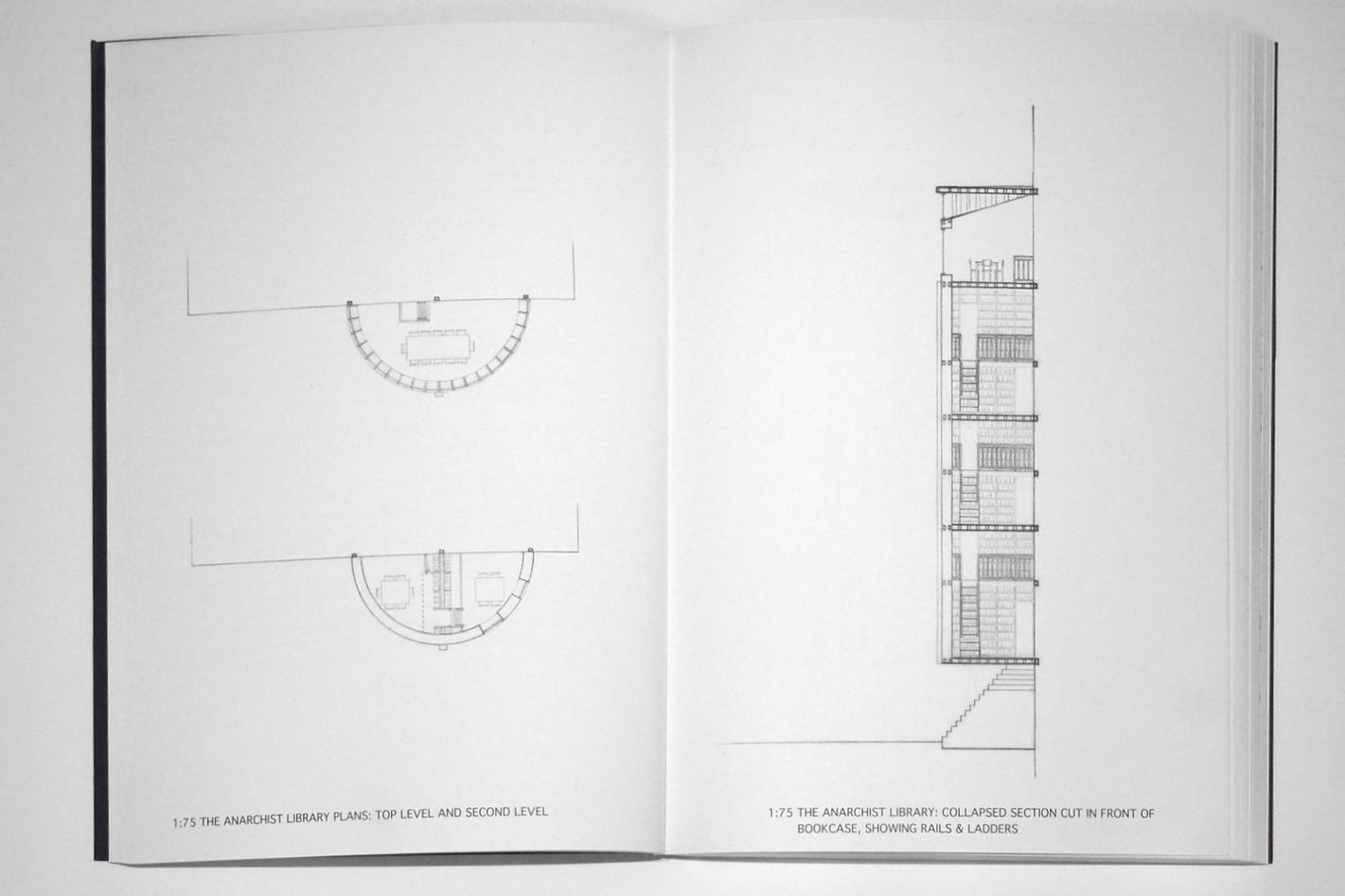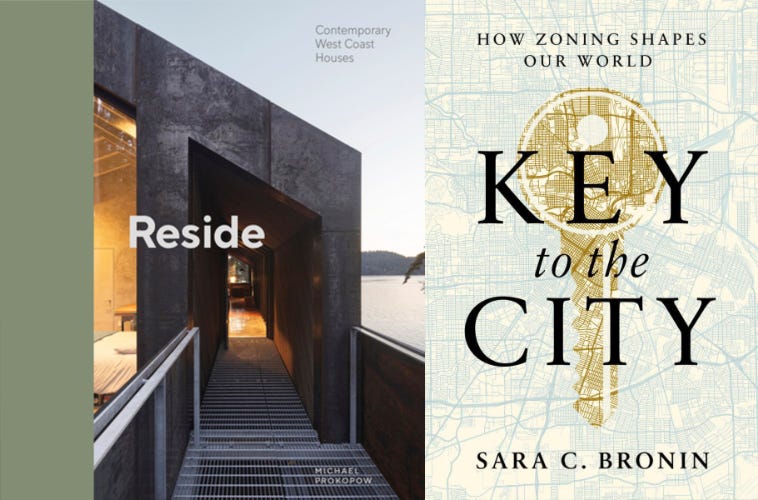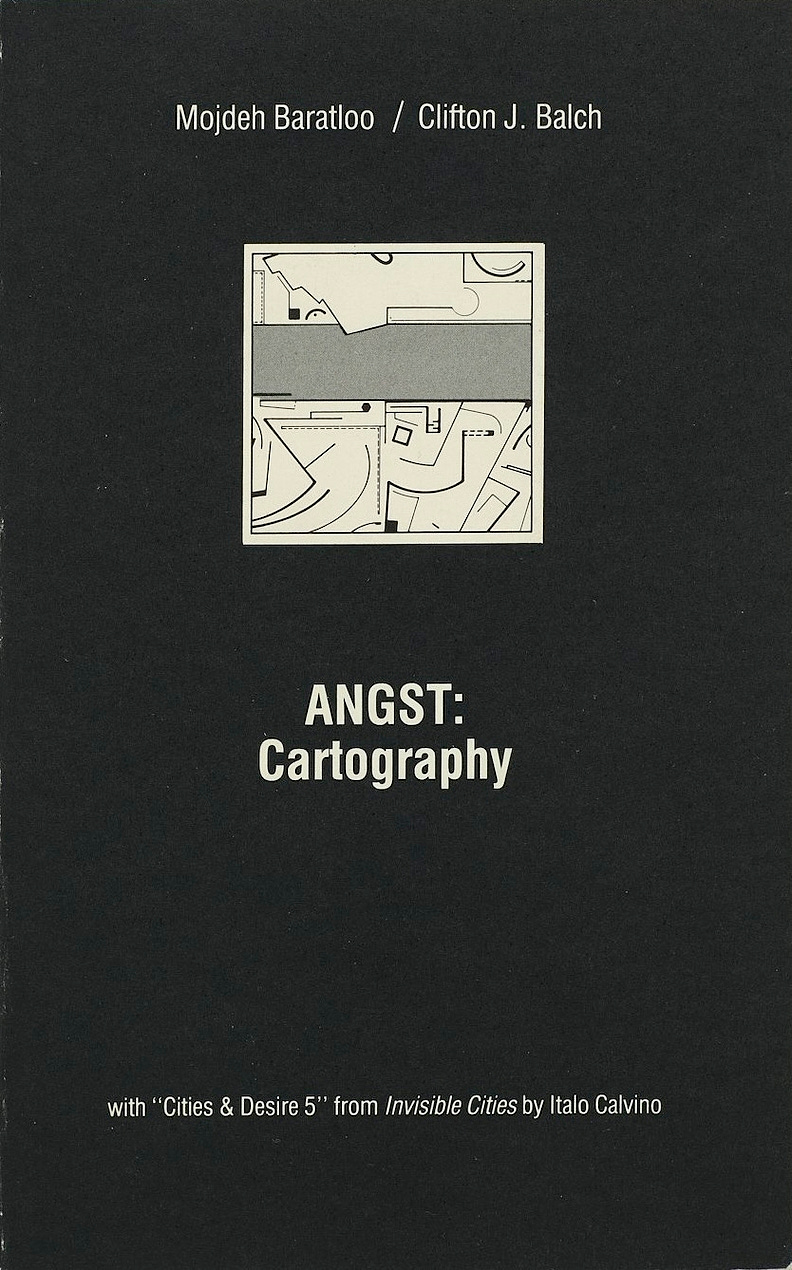This newsletter for the week of September 30 delves into Seeing Fire | Seeing Meadows by Anna Kostreva as Book of the Week, briefly presents four new books hitting bookstores, links to three headlines related to architecture books, and grabs a couple older books off the shelf: Keith Krumwiede’s Atlas of Another America: An Architectural Fiction and Angst: Cartography by Mojdeh Baratloo and Clifton J. Balch. Happy reading!
Book of the Week:
Seeing Fire | Seeing Meadows by Anna Kostreva (Buy from Public Knowledge Books / from Amazon)
Described as “a novel that foregrounds architecture into storytelling,” Seeing Fire | Seeing Meadows (Plural Studio, 2023) begins with Nathalie, an architect and the book’s narrator, presenting her project, the Cemetery of Digital Identities, at the KRITiK bar in Berlin. Her talk is interspersed with drawings — hand drawings, it is worth noting — that describe the layout and details of the cemetery’s six gallery-like rooms, each one devoted to a digital identity: the “Follower,” the “Connection,” the “Creator,” the “Member,” the “User,” and the “Friend.” It is a project clearly rooted in the digital reality of the present day, but the story that follows is set in a not-too-distant future, or perhaps a not-too-alternative reality, in which the extent to which people have given their lives over to technology is extreme. Instead of apps, algorithms, and AI existing as tools for people to use as needed, like now, people willingly give in to tech’s dictates so they can become who and what they want to become. Want a certain lifestyle, job, or celebrity status? The subscription service, or subs, will tell you how to get it, as long as you follow its directions: where you live, work, eat, drink, who your friends are, etc.
The story at the heart of Seeing Fire | Seeing Meadows has technology and those in control of it eroding free choice and other things that make us human. Most people opt in, leaving a small band of insurgents who want to defeat the subs and their control over people’s lives. Nathalie, who I’m guessing is a surrogate for the book’s author, Anna Kostreva, is drawn into the opposition that night at the KRITiK bar. As a narrator who is an architect, she describes the story’s events in words and depicts their settings in drawings. So readers see a floor plan and other drawings of the Japanese-inflected Forest Retreat (above), details of how the Faraday Bus enables the group to talk without being tracked by the subs, and the layout of the Anarchist Library (below) that was built after the Wall came down. Like the opening pages, the hand drawings of fictional places with poetic names (Monument to Rejecting Exploitation, Silent Retreat, Cemetery of the Digital Individual) later in the book immediately reminded me of John Hejduk, as well as Raimund Abraham, Lebbeus Woods, Douglas Darden, and other architects whose ideas, and drawings of them, far outnumbered their actual buildings. Some of them are mentioned in the book, no doubt reflecting Kostreva’s education at Cooper Union, whose hallways and studios are looked over by the ghosts of Hejduk, Abraham, Woods, and Diane Lewis.
Given that the book is a novel — or a piece of “archifiction,” as described in a piece at Drawing Matter — I don’t want to give away too much of the story. I will say that, even though it involves tech details that might put people to sleep if they were hearing the same in a lecture, Kostreva’s writing early in the book manages to adeptly draw readers into the story, immersing them in a reality where our devices are more powerful than we could imagine. I’ll also point out that the drawings and architectural references that make the book a work of “archifiction” are loaded primarily into the first and last of the book’s four parts; in between are long stretches of dialogue free of drawings but full of advancing narrative. This structure, if you will, gives the book a nice circular arc, with its ending returning to its beginning, but in a way that is unexpected, poetic, and thought-provoking. It is an ending in which the book’s title and cover illustration make sense.
Ultimately, Kostreva’s book of words and drawings tackles issues that are played out in the interaction between the physical and the virtual. Today’s surveillance capitalism and social inequality, for instance, are taken to an high level in the book, with “basic subs users” able to traverse small stretches of the city compared to “elite subs users,” who have more of the city at their disposal. I can’t help but think back to the 1990s, when the internet was a place of freedom, untouched by capitalism — the opposite of what it is today. In Kostreva’s “archifiction,” the internet-spawned subs “serve an economic system that protects social hierarchy above all else” and “will be the new invisible hand.” As such, Seeing Fire | Seeing Meadows is clearly more dystopian than utopian, but it does offer hope in the characters that inhabit it and in the places they imagine.
Books Released This Week:
(In the United States, a curated list)
Form Follows Love: Building by Intuition – From Bangladesh to Europe and Beyond by Anna Heringer (Buy from Birkhäuser / from Amazon / from Bookshop) — Among other things, this monograph on Anna Heringer, known for the METI Handmade School in Bangladesh and other buildings made with rammed earth and clay, features an in-depth talk with her and author Dominique Gauzin-Müller.
Vector Architects: Gong Dong and the Art of Building edited by Botond Bognar (Buy from Rizzoli / from Amazon / from Bookshop) — This monograph documents the “high quality, quietly rich, and greatly rewarding architecture” of Vector Architects, the Beijing studio founded by Gong Dong in 2008.
Reside: Contemporary West Coast Houses by Michael Prokopow (Buy from Figure 1 Publishing / from Amazon / from Bookshop) — This survey of West Coast houses focuses on British Columbia, with contributions that “range from palatial mountain chalets to cabins sitting lightly in the forest to oceanfront retreats to sensitive urban renovations.”
Key to the City: How Zoning Shapes Our World by Sara C. Bronin (Buy from W. W. Norton / from Amazon / from Bookshop) — Legal scholar and architect Sara C. Bronin examines how zoning, which primarily dictates the use and bulk of buildings, “became such a prevailing force and reveals its impact — and its potential for good.”
Full disclosure: As an Amazon Associate, AbeBooks Affiliate, and Bookshop.org Affiliate, I earn commissions from qualifying purchases made via any relevant links above and below.
Book News:
Designboom presents some images from inside Paul Tulett's Brutalist Japan: A Photographic Tour of Post-War Japanese Architecture (Prestel, coming in November).
Columbia News speaks with Mabel O. Wilson about a new role she is undertaking as the chair of the African American and African Diaspora Studies (AAADS) department at Columbia University, while also touching on her forthcoming book, Building Race and Nation: How Slavery and Dispossession Shaped U.S. Civic Architecture.
In a short obituary for Fredric Jameson (1934–2024) at World-Architects, I listed a few of the essays and book chapters he wrote that pertain to architecture.
From the Archives:
This week’s “Book of the Week” has me thinking of architectural fiction, a niche genre that I’ll admit I’ve found more lacking than fulfilling. One of my favorites though is Keith Krumwiede’s 2016 book, Atlas of Another America: An Architectural Fiction, which I reviewed on my blog back in 2017, describing it as “more a graphical narrative than an architect's attempt to force a fictional story into an architectural wrapper.” The atlas-sized book depicts the fictional Freedomland through maps, plans, and depictions of homes in historical paintings. The whole is an intelligent and humorous critique of home ownership and the house plans developed by large-scale home builders in the United States. I liked the “archifiction” so much I included it, a few years later, in Buildings in Print: 100 Influential & Inspiring Illustrated Architecture Books.
The cover of Angst: Cartography, the 1989 book by architects Mojdeh Baratloo and Clifton J. Balch that was published by SITES/Lumens and replaced an issue of SITES magazine, indicates that it includes “Cities & Desire 5” from Italo Calvino’s Invisible Cities, the classic 1972 novel in which Marco Polo describes to Kublai Khan 55 imaginary cities. When I was in architecture school, Invisible Cities was a must-read, especially for those of us spending a semester in Italy for foreign study, given that, in the end, all 55 fictional cities are descriptions of Venice. The chapter devoted to Zobeide in Calvino’s book is presented as a footer in Angst: Cartography, accompanying drawings that are modifications of Sanborn maps. Each spread has a drawing/map and line from Invisible Cities on the right, opposite a corresponding, inverted b/w photograph of Brooklyn’s Gowanus Canal area on the left. In hindsight, the whole can be seen as an invitation to look at the toxic industrial area through an alternative lens ahead of its inevitable redevelopment this century. The resulting developmennts, still in the works and still reckoning with the area’s industrial pollution, indicate that business as usual — as usual — trumped creativity, in this case of the cartographical nature.
Thank you for subscribing to A Weekly Dose of Architecture Books. If you have any comments or questions, or if you have your own book that you want to see in this newsletter, please respond to this email, or comment below if you’re reading this online. All content is freely available, but paid subscriptions that enable this newsletter to continue are welcome — thank you!
— John Hill

